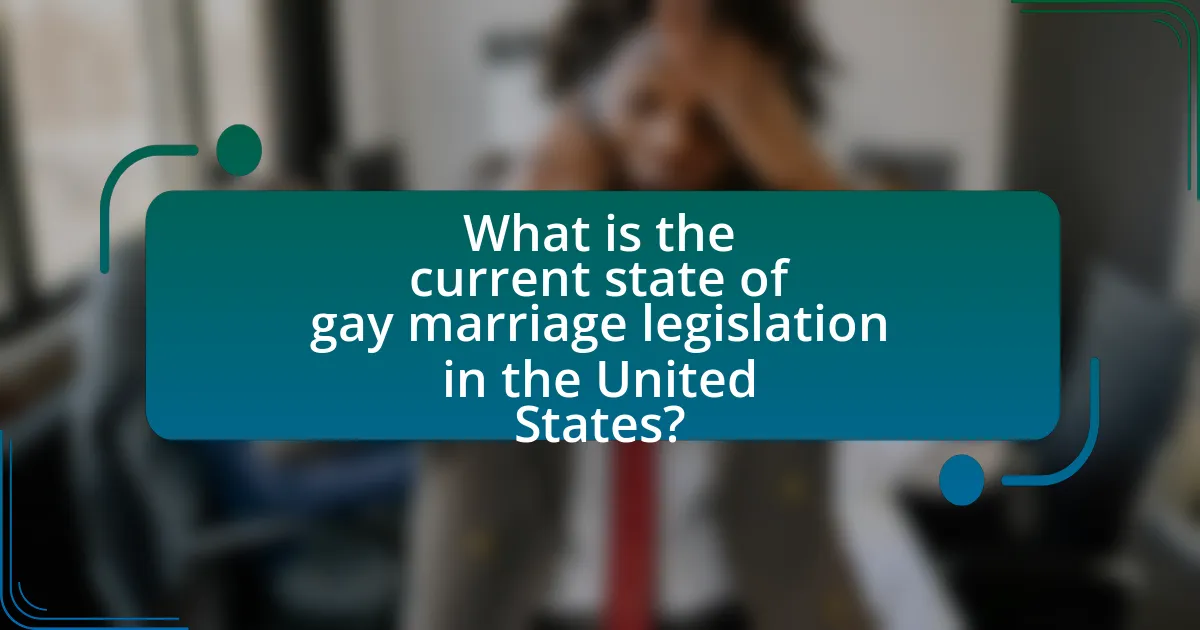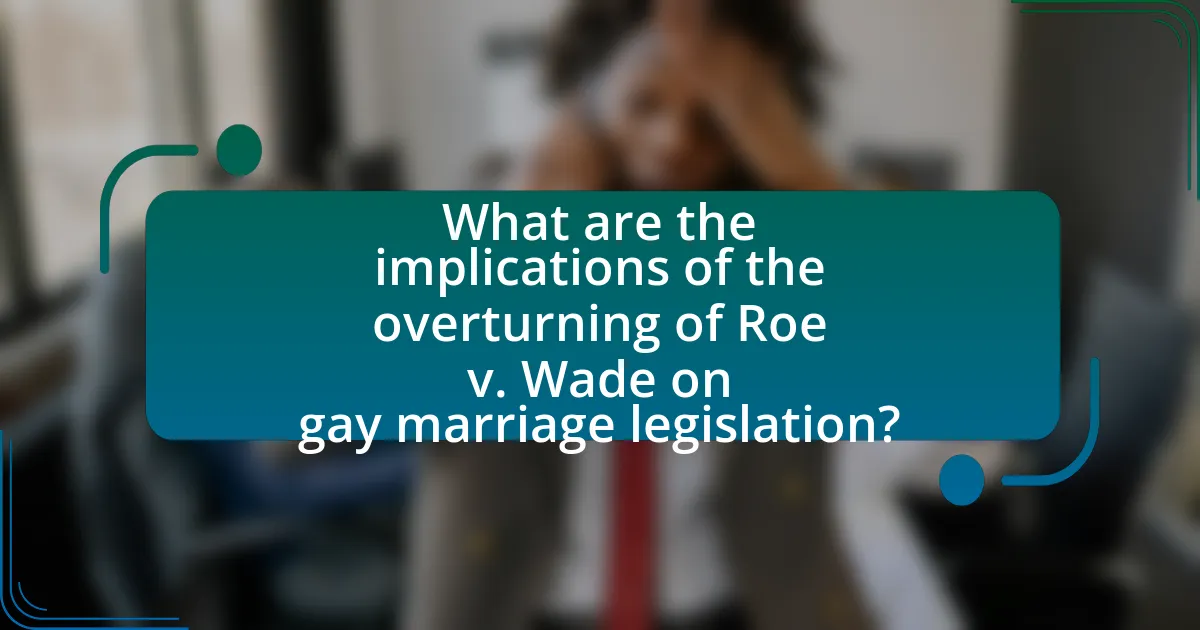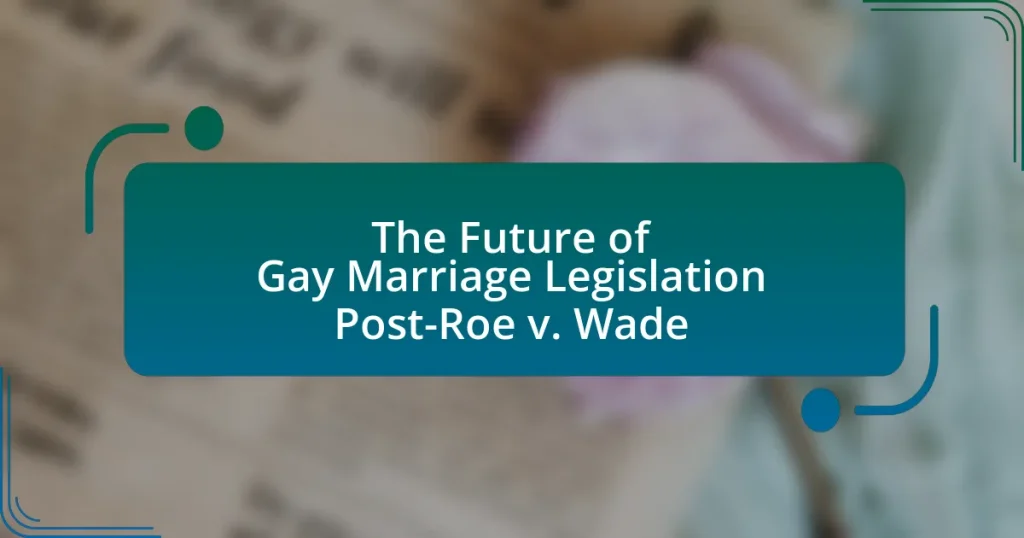The article examines the current state of gay marriage legislation in the United States following the Supreme Court’s 2015 decision in Obergefell v. Hodges, which legalized same-sex marriage nationwide. It outlines the evolution of legal rights for LGBTQ+ individuals, key court cases that have shaped marriage equality, and the implications of the recent overturning of Roe v. Wade on these rights. The discussion includes potential legislative changes, public opinion trends, and the role of advocacy groups in protecting marriage equality. Additionally, it highlights the interconnectedness of reproductive rights and marriage equality, emphasizing the ongoing challenges and future trends in the legal landscape for gay marriage.

What is the current state of gay marriage legislation in the United States?
Gay marriage is currently legal across the United States, following the Supreme Court’s decision in Obergefell v. Hodges in 2015, which established the constitutional right to same-sex marriage. This landmark ruling affirmed that states cannot deny marriage licenses to same-sex couples, thereby ensuring marriage equality nationwide. As of now, there have been no significant federal legislative efforts to overturn this ruling, although some states have introduced measures that could impact LGBTQ+ rights.
How has the legal landscape for gay marriage evolved over the years?
The legal landscape for gay marriage has evolved significantly, particularly marked by the landmark Supreme Court decision in Obergefell v. Hodges in 2015, which legalized same-sex marriage nationwide in the United States. Prior to this ruling, various states had differing laws regarding same-sex marriage, with some allowing it and others banning it through constitutional amendments or statutes. The progression began in the late 20th century, with Massachusetts becoming the first state to legalize gay marriage in 2004, followed by a gradual increase in states recognizing same-sex unions. The Obergefell decision was based on the constitutional principles of equal protection and due process, affirming that same-sex couples have the same legal rights to marry as opposite-sex couples. This ruling has since influenced ongoing discussions and legislation regarding LGBTQ+ rights, especially in the context of potential challenges to marriage equality following shifts in the Supreme Court’s composition and rulings on related issues.
What key court cases have influenced gay marriage rights?
Key court cases that have influenced gay marriage rights include Obergefell v. Hodges (2015), which legalized same-sex marriage nationwide by ruling that state bans on same-sex marriage violated the Fourteenth Amendment’s Equal Protection and Due Process Clauses. Another significant case is United States v. Windsor (2013), where the Supreme Court struck down the Defense of Marriage Act (DOMA), affirming that the federal government must recognize same-sex marriages performed in states where they are legal. Additionally, Lawrence v. Texas (2003) decriminalized same-sex sexual activity, laying the groundwork for future marriage equality cases. These rulings collectively advanced the legal recognition and rights of same-sex couples in the United States.
How have state laws changed regarding gay marriage?
State laws regarding gay marriage have evolved significantly, particularly following the 2015 Supreme Court decision in Obergefell v. Hodges, which legalized same-sex marriage nationwide. Prior to this ruling, many states had enacted laws either banning same-sex marriage or limiting recognition of such unions. Post-Obergefell, most states have aligned their laws to recognize same-sex marriage, although some states have attempted to introduce legislation that could undermine these rights, reflecting ongoing debates about marriage equality. For instance, in recent years, states like Texas and Florida have proposed bills that could allow for discrimination against same-sex couples in certain contexts, indicating that while legal recognition exists, challenges to equality persist.
What role did Roe v. Wade play in shaping marriage equality?
Roe v. Wade played a significant role in shaping marriage equality by establishing a legal precedent for the recognition of personal privacy and individual rights. The Supreme Court’s decision in 1973 emphasized the importance of personal autonomy, which later influenced cases related to same-sex marriage, such as Obergefell v. Hodges in 2015. The legal reasoning in Roe v. Wade, particularly regarding the right to make personal decisions without government interference, laid the groundwork for arguments advocating for marriage equality, asserting that the government should not dictate the intimate choices of individuals, including whom they choose to marry.
How did the Roe v. Wade decision impact LGBTQ+ rights?
The Roe v. Wade decision significantly influenced LGBTQ+ rights by establishing a legal precedent for privacy and bodily autonomy, which later supported arguments for same-sex marriage and LGBTQ+ rights. The ruling, decided in 1973, affirmed that individuals have the right to make personal decisions regarding their bodies without excessive government interference. This principle of privacy laid the groundwork for subsequent legal battles, including those for marriage equality, culminating in the Obergefell v. Hodges decision in 2015, which legalized same-sex marriage nationwide. The connection between reproductive rights and LGBTQ+ rights has been emphasized by advocates who argue that both hinge on the recognition of individual autonomy and equal protection under the law.
What parallels can be drawn between reproductive rights and marriage equality?
Reproductive rights and marriage equality both center on individual autonomy and the right to make personal choices without government interference. Both movements advocate for the recognition of personal freedoms, emphasizing that individuals should have the authority to make decisions regarding their bodies and relationships. Historical context shows that both issues have faced significant legal and societal challenges; for instance, the landmark Supreme Court cases Roe v. Wade (1973) for reproductive rights and Obergefell v. Hodges (2015) for marriage equality highlight the ongoing struggle for civil rights in the United States. Additionally, both movements have mobilized grassroots activism and public support, demonstrating a collective demand for equality and justice.

What are the implications of the overturning of Roe v. Wade on gay marriage legislation?
The overturning of Roe v. Wade raises concerns about the stability of gay marriage legislation, as it signals a potential shift in judicial interpretation of rights previously considered settled. The Supreme Court’s decision in Dobbs v. Jackson Women’s Health Organization indicates a willingness to reconsider established precedents, which could threaten the legal foundation of same-sex marriage established by Obergefell v. Hodges in 2015. Legal experts warn that if the Court continues to adopt a more restrictive view of personal liberties, it may open the door for challenges to gay marriage rights, as the rationale for protecting such rights could be undermined by the same arguments used to overturn Roe v. Wade.
How might the reversal of Roe v. Wade affect LGBTQ+ rights?
The reversal of Roe v. Wade may negatively impact LGBTQ+ rights by setting a precedent for the reconsideration of established rights related to marriage and family. Legal experts argue that the same arguments used to overturn Roe could be applied to challenge the legal foundations of same-sex marriage, as both rely on interpretations of privacy and personal autonomy. For instance, Justice Clarence Thomas indicated in his concurring opinion that the Court should reconsider cases like Obergefell v. Hodges, which legalized same-sex marriage. This suggests a potential vulnerability for LGBTQ+ rights in the wake of Roe’s reversal, as it opens the door for future legal challenges that could undermine protections previously established for the LGBTQ+ community.
What legal arguments could be used to challenge gay marriage post-Roe?
Legal arguments that could be used to challenge gay marriage post-Roe include the assertion that marriage is a state-regulated institution, allowing states to define marriage according to their own laws. This argument is supported by the Tenth Amendment, which reserves powers not delegated to the federal government to the states. Additionally, opponents may invoke religious freedom protections, arguing that state recognition of gay marriage infringes on the rights of individuals and organizations to act according to their religious beliefs. Historical precedents, such as the Supreme Court’s decisions in cases like Obergefell v. Hodges, could be re-evaluated in light of changing judicial philosophies, particularly if the Court shifts towards a more originalist interpretation of the Constitution.
How do state-level decisions impact federal recognition of gay marriage?
State-level decisions significantly influence federal recognition of gay marriage by establishing legal precedents and shaping public opinion. For instance, when states legalize gay marriage, they create a framework that can lead to broader acceptance and eventual federal recognition, as seen in the progression leading to the Supreme Court’s decision in Obergefell v. Hodges in 2015, which legalized gay marriage nationwide. Additionally, states that enact laws against gay marriage can create legal challenges that may reach federal courts, impacting the interpretation of constitutional rights related to marriage equality. This dynamic illustrates how state actions can either support or hinder the federal government’s stance on gay marriage.
What potential legislative changes could arise in response to Roe v. Wade’s overturning?
Potential legislative changes in response to Roe v. Wade’s overturning include the introduction of state-level laws that either restrict or protect abortion rights, as well as potential federal legislation aimed at codifying abortion rights. Following the Supreme Court’s decision, several states have enacted laws to ban or severely limit abortions, while others are considering measures to safeguard access to reproductive healthcare. For instance, states like Texas and Alabama have implemented strict abortion bans, while states such as California and New York have moved to enhance protections for abortion services. Additionally, the federal government may respond by proposing legislation to ensure reproductive rights at the national level, similar to the Women’s Health Protection Act, which aims to protect the right to access abortion services across the country.
What are the risks of new laws targeting marriage equality?
New laws targeting marriage equality pose several risks, including the potential for increased discrimination against LGBTQ+ individuals. Such legislation can undermine existing protections, leading to legal challenges that may restrict marriage rights based on sexual orientation. For instance, in 2022, the U.S. Supreme Court’s decision in Dobbs v. Jackson Women’s Health Organization raised concerns about the stability of precedents related to personal liberties, including marriage equality established in Obergefell v. Hodges. This context suggests that new laws could embolden states to enact measures that limit or roll back marriage rights, creating a patchwork of legal recognition that varies significantly across jurisdictions. Additionally, these laws may foster societal division and stigmatization, further marginalizing LGBTQ+ communities.
How might advocacy groups respond to potential legislative changes?
Advocacy groups may respond to potential legislative changes by mobilizing public campaigns to influence lawmakers and raise awareness about the implications of such changes. For instance, following the overturning of Roe v. Wade, organizations like the Human Rights Campaign and GLAAD have intensified efforts to protect LGBTQ+ rights, emphasizing the interconnectedness of reproductive and marriage rights. These groups often utilize social media, organize protests, and engage in lobbying activities to ensure that their voices are heard in the legislative process. Historical examples include the swift mobilization of advocacy groups in response to the Defense of Marriage Act in the 1990s, which led to significant public discourse and eventual legislative changes favoring marriage equality.

What future trends can we anticipate for gay marriage legislation?
Future trends in gay marriage legislation indicate a potential increase in state-level protections and a focus on anti-discrimination measures. Following the Supreme Court’s decision in Dobbs v. Jackson Women’s Health Organization, which overturned Roe v. Wade, there has been a heightened awareness of the vulnerability of established rights, including marriage equality. This has prompted advocacy groups to push for stronger legal frameworks at both state and federal levels to safeguard against potential rollbacks. For instance, the Respect for Marriage Act, passed by the U.S. House of Representatives in 2022, aims to codify same-sex marriage rights, reflecting a legislative trend towards reinforcing protections amid shifting judicial landscapes.
How are public opinions shifting regarding gay marriage?
Public opinions regarding gay marriage are increasingly supportive, with recent surveys indicating that approximately 70% of Americans now favor legal recognition of same-sex marriage. This shift is evidenced by a significant increase in acceptance over the past two decades; for instance, in 2004, only about 30% supported gay marriage. Factors contributing to this change include greater visibility of LGBTQ+ individuals in media and society, as well as generational shifts, with younger voters showing overwhelming support for marriage equality. Additionally, legal milestones, such as the Supreme Court’s 2015 decision in Obergefell v. Hodges, which legalized same-sex marriage nationwide, have further solidified public support.
What demographic factors influence support for gay marriage?
Support for gay marriage is influenced by several demographic factors, including age, education level, religious affiliation, and geographic location. Younger individuals tend to show higher levels of support, with studies indicating that approximately 70% of those aged 18-29 favor gay marriage, compared to lower percentages in older age groups. Education also plays a significant role; individuals with higher education levels are more likely to support gay marriage, as evidenced by surveys showing that college graduates support it at rates exceeding 60%.
Religious affiliation impacts views on gay marriage, with more liberal denominations, such as Unitarian Universalists, showing strong support, while conservative groups, like evangelical Christians, often oppose it. Geographic location further influences attitudes, with urban areas generally exhibiting greater support compared to rural regions. For instance, a 2021 Gallup poll found that support for gay marriage was over 70% in urban settings, while it was significantly lower in rural areas. These demographic factors collectively shape public opinion and legislative outcomes regarding gay marriage.
How do cultural attitudes impact legislative changes?
Cultural attitudes significantly influence legislative changes by shaping public opinion and political priorities. For instance, as societal acceptance of LGBTQ+ rights has increased, many jurisdictions have enacted laws supporting same-sex marriage, reflecting a shift in cultural norms. A study by Pew Research Center in 2021 indicated that 70% of Americans support same-sex marriage, demonstrating how evolving cultural attitudes can lead to legislative advancements. This correlation between public sentiment and lawmaking illustrates that as cultural acceptance grows, legislators are more likely to respond with supportive policies, thereby facilitating changes in legislation.
What strategies can advocates employ to protect gay marriage rights?
Advocates can employ legal strategies, public awareness campaigns, and coalition-building to protect gay marriage rights. Legal strategies include challenging discriminatory laws in court, as seen in landmark cases like Obergefell v. Hodges, which legalized same-sex marriage nationwide in 2015. Public awareness campaigns can educate the public on the importance of marriage equality, leveraging statistics that show broad support for gay marriage, such as a 2021 Gallup poll indicating that 70% of Americans support same-sex marriage. Coalition-building with other civil rights organizations can strengthen advocacy efforts, creating a united front to influence legislation and public opinion.
How can grassroots movements influence policy decisions?
Grassroots movements can influence policy decisions by mobilizing public support and creating pressure on lawmakers. These movements often engage in advocacy campaigns, organize protests, and utilize social media to raise awareness about specific issues, such as gay marriage legislation. For instance, the Human Rights Campaign played a significant role in the legalization of same-sex marriage in the United States by rallying supporters and lobbying Congress, which culminated in the Supreme Court’s decision in Obergefell v. Hodges in 2015. This demonstrates that grassroots efforts can effectively shape public opinion and lead to significant legal and policy changes.
What role does litigation play in safeguarding marriage equality?
Litigation plays a crucial role in safeguarding marriage equality by challenging discriminatory laws and practices in courts. Through landmark cases, such as Obergefell v. Hodges in 2015, litigation has established the constitutional right to same-sex marriage, affirming that denying this right violates the Equal Protection and Due Process Clauses of the Fourteenth Amendment. This judicial intervention not only protects existing rights but also sets legal precedents that can prevent future rollbacks of marriage equality, ensuring that same-sex couples maintain equal access to marriage across the United States.
What practical steps can individuals take to support gay marriage legislation?
Individuals can support gay marriage legislation by actively engaging in advocacy efforts, such as contacting their elected representatives to express support for marriage equality. This direct communication can influence lawmakers, as studies show that constituents’ opinions significantly impact legislative decisions. Additionally, individuals can participate in local and national campaigns that promote awareness and education about the importance of gay marriage rights, which can help shift public opinion and garner broader support. Volunteering for organizations that focus on LGBTQ+ rights, such as the Human Rights Campaign, can also amplify efforts to promote legislative change. Furthermore, attending rallies and events dedicated to marriage equality demonstrates public support, which can pressure lawmakers to act favorably on related legislation.


